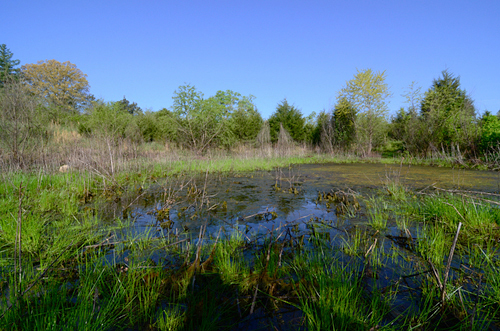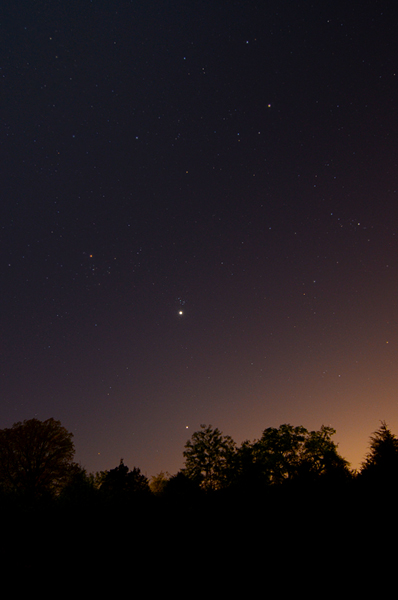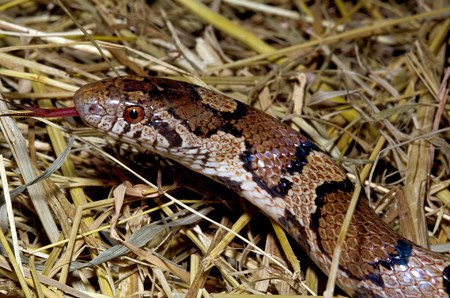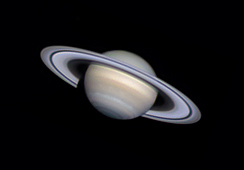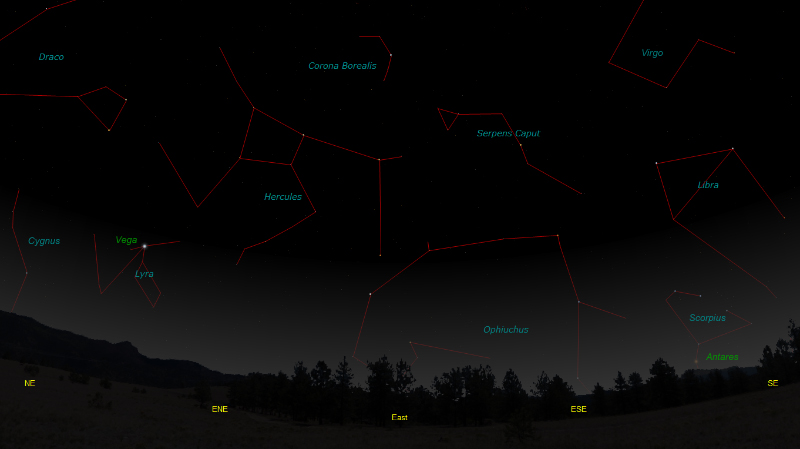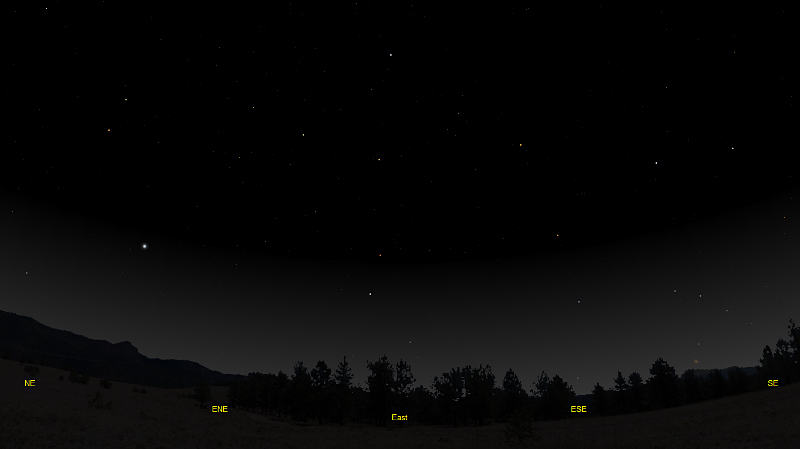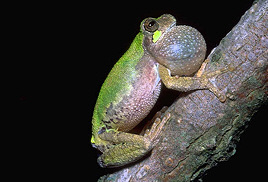The purpose of this feature is to give scout leaders, educators and naturalists an idea of some of the natural events coming up each month. We will try to cover a variety of natural events ranging from sky events to calling periods of amphibians, bird and mammal watching tips, prominent wildflowers and anything else that comes to mind. We will also note prominent constellations appearing over the eastern horizon at mid-evening each month for our area for those who would like to learn the constellations. If you have suggestions for other types of natural information you would like to see added to this calendar, let us know! Note: You can click on the hyperlinks to learn more about some of the featured items. To return to the Calendar, hit the "back" button on your browser, NOT the "back" button on the web page. All charts are available in a "printer friendly" mode, with black stars on a white background. Left clicking on each chart will take you to a printable black and white image. Please note that images on these pages are meant to be displayed at 100%. If your browser zooms into a higher magnification than that, the images may lose quality. Though we link book references to nationwide sources, we encourage you to support your local book store whenever possible. Notes and Images From April 2012
Our Pond Morning and Evening: To the right and below are images of our pond taken on April 1st. Both the landscape and the soundscape change quickly in April. At the beginning of the month, a Brown Thrasher often perched in the top of our White Oak, singing its raspy two-note variations. As the month progressed, White-eyed Vireos, Common Yellowthroats, Prairie Warblers, Palm Warblers and Yellow-breasted Chats all added their voices to the field. An Eastern Phoebe nested in our barn. The leaves on our White Oak changed from a just-emerged yellow-orange to a deep green. Dragonflies flitted over the pond and buttercups covered its banks. The white blossoms of blackberries appeared everywhere. On one memorable occasion, we saw a Red Fox cross the railroad tracks and head into our field.
But there were also a few goodbyes. Jupiter appeared just above the tree line at the first of the month, and gradually faded into the twilight glow during the month. In the image at right, brighter Venus is above Jupiter, and just below the Pleiades, a pretty open cluster. Our Broad-tipped Conehead, who surprised us by calling in March, stopped calling by the end of April. In our area they only call in early spring. Prominent among the new arrivals were the fireflies. Easterners tend to take them for granted, but those living in the western parts of this country do not see our nightly spectacle. In the firefly's abdomen, a substance called luciferin (from the Latin lucifer, meaning "light-bearer") is oxidized in the presence of a enzyme to produce light. Lucifer was also an ancient word for Venus as seen in the morning sky (the morning "star"). Only later was the word used in association with Satan in some religions. In the Aztec and Mayan cultures, Venus was associated with the god Quetzalcoatl. This god was believed to be represented in the earthly realm by the Resplendent Quetzal, arguably one of the most beautiful birds on earth. These cultures believed the gradual disappearance of Venus into the Sun's glare (as it does this May, see below) represented the descent of Quetzalcoatl into his funeral pyre. Quetzalcoatl's heart was said to emerge from the pyre to become the morning star. Update: It's rare for Venus to transit the face of the Sun when it passes between the Earth and the Sun. On June 5th, Venus will transit the Sun. After that, the next transit will not occur for over 100 years! For an inexpensive and safe way to view the transit with a small telescope, see the article here. You'll need to order the parts soon in order to get them in time for the transit. Stay safe while observing the Sun. Never look at the Sun even briefly through any sort of unfiltered optical equipment. You can do instantaneous and permanent damage to your eyes. Be sure and cover up or remove the finder telescope. Mount your solar filter or safe viewing device before you aim your telescope at the Sun. Don't look at the Sun to aim your telescope; look instead at the shadow of your telescope tube, and simply point the telescope so that the tube shadow is round. We'll have more information on the transit in the June Natural Calendar.
We have four dogs. I found Rion (a contraction of Orion) barking at an Eastern Milk Snake on our front porch. I was able to get to the snake before he hurt it, and we released it unharmed into our barn that evening. These beautiful and beneficial snakes are associated with rather strange folklore. The common name comes from an old belief of some farmers that the snakes somehow sucked cow udders to get milk, thereby depriving the farmer of his or her rightful share. There is of course no possible way a snake could perform this feat, but the snakes are found commonly in barns, and this may be the source of the myth. The real reason they frequent barns is to hunt rodents, and they are actually very beneficial to landowners. These snakes have smooth, not keeled, scales. They kill their prey by constriction and are completely harmless to humans. Like many non-venomous snakes, they will vibrate the tip of their tail when threatened, which makes some people think they are a type of rattlesnake. This results in the needless killing of many of these beautiful snakes. Note the round pupils of this snake. All venomous snakes in Tennessee have vertical pupils.
Sky Events for May 2012: The Eta Aquariid Meteor Shower peaks on May 5th, but a full Moon will hinder the view. A Partial Eclipse of the Sun will occur on May 20th. This eclipse will be annular farther west. In our part of the country the Sun will set while partially eclipsed, which could make for some interesting views. Always use some sort of approved solar filter when looking at the Sun, or project the image with a pinhole. Directions for doing this can be found on the Sky and Telescope website. You'll also need a flat western horizon to catch the eclipse. Evening Sky: Venus puts on quite a show this month as it sinks back into the twilight glow. The planet is passing between the Earth and the Sun, which means that it will show an increasingly larger and thinner crescent phase as the month progresses. The thin crescent becomes almost a minute of an arc in diameter, larger than the apparent size of any other planet. In the final week of the month the crescent phase should be visible in binoculars. To see the tiny crescent through drifting clouds is a sight to be remembered. Be sure, however, that the Sun has already set before you begin to look for it, lest you damage your eyes by sweeping across the solar disk. After the Sun sets, try to find Venus as soon as possible, before the sky gets dark. You'll get a better view that way. Some people with extremely good vision have been able to see the crescent with the naked eye. If you think you can, sketch the orientation of the crescent before you sneak a peak in binoculars. Look for Mars about 64 degrees above the southeastern horizon at dusk on May 1st. The planet will remain in Leo. It continues to fade, and telescopically its apparent size will shrink from 10 seconds of an arc to around 8 seconds of an arc by the end of the month. Still, better try to catch a glimpse now - it will be a little over two years until the next close approach. To see which side is visible, I recommend the Mars Profiler at the Sky and Telescope web site.
Saturn is about 20 degrees above the ESE horizon at dusk on May 1st, in Virgo. Look for it near the bright star Spica. To find Spica, find the handle of the "Big Dipper", then "arc to Arcturus, then on to Spica." Best telescopic views occur when it is due south around 11:30pm. Saturn is stunning in just about any size telescope. See if you can make out Cassini's division in the rings, which appears like a thin black division in the rings. Those using larger telescopes can try for the faint "Crepe" ring, the translucent innermost ring of the ring system, or Encke's division, a faint division in the outermost ring. Finally, look for a very thin crescent Moon about 30 minutes after sunset on May 21st. Binoculars should help spot the slender crescent. Constellations: The views below show the sky looking east at 9:30pm CDT on May 15th. The first view shows the sky with the constellation outlined and names depicted. Star and planet names are in green. Constellation names are in blue. The second view shows the same scene without labels. New constellations this month in the eastern sky are Lyra, the Lyre, with it's bright star Vega, Serpens Caput, the head of the Serpent, and Libra, the Scales. The red giant Antares (the name means Rival of Mars) is just making its way over the eastern horizon in Scorpius. Ophiuchus, the Serpent Bearer, is also climbing into view.
On Learning the Constellations: We advise learning a few constellations each month, and then following them through the seasons. Once you associate a particular constellation coming over the eastern horizon at a certain time of year, you may start thinking about it like an old friend, looking forward to its arrival each season. The stars in the evening scene above, for instance, will always be in the same place relative to the horizon at the same time and date each May. Of course, the planets do move slowly through the constellations, but with practice you will learn to identify them from their appearance. In particular, learn the brightest stars (Like Vega and Antares in the above scene looking east), for they will guide you to the fainter stars. Once you can locate the more prominent constellations, you can "branch out" to other constellations around them. It may take you a little while to get a sense of scale, to translate what you see on the computer screen or what you see on the page of a book to what you see in the sky. Look for patterns, like the stars that make up the constellation Hercules. The earth's rotation causes the constellations to appear to move across the sky just as the sun and the moon appear to do. If you go outside earlier than the time shown on the charts, the constellations will be lower to the eastern horizon. If you observe later, they will have climbed higher. As each season progresses, the earth's motion around the sun causes the constellations to appear a little farther towards the west each night for any given time of night. If you want to see where the constellations in the above figures will be on June 15th at 9:30pm CDT, you can stay up till 11:30pm CDT on May 15th and get a preview. The westward motion of the constellations is equivalent to two hours per month. Recommended: Sky & Telescope's Pocket Star Atlas is beautiful, compact star atlas. It is destined to become a classic, and is a joy to use at the telescope. A good book to learn the constellations is Patterns in the Sky, by Hewitt-White. You may also want to check out at H. A. Rey's classic, The Stars, A New Way to See Them. For skywatching tips, an inexpensive good guide is Secrets of Stargazing, by Becky Ramotowski. A good general reference book on astronomy is the Peterson
Field Guide,
A Field Guide to the Stars and Planets, by Pasachoff. The book retails for around $14.00. Starry Night has several software programs for learning the night sky. Visit the Starry Night web site at www.starrynight.com for details.
Amphibians:
By the end of May all of Tennessee's frogs and toads are either calling or have already reached their peak calling period and are being heard less. The treefrogs are the last of our frogs and toads to start calling. Cope's Gray Treefrog and Gray Treefrogs start giving isolated calls as early as March, and by the end of this month listen also for Bird-Voiced Treefrogs, Green Treefrogs and Barking Treefrogs. In May we also hear Fowler's Toads calling frequently, so listen for their "crying baby" call. Northern Cricket Frogs are hitting their stride as well. Listen for a sound like two stones being tapped together. We have heard eight or more species of frogs calling on some May evenings, so it's a great time to listen. Upland Chorus Frogs and Spring Peepers continue to call. Listen for their calls to increase in pitch and quicken with the rising temperatures. Recommended: The Frogs and Toads of North America, Lang Elliott, Houghton Mifflin Co.
Archives (Remember to use the back button on your browser, NOT the back button on the web page!) Natural Calendar February 2012 Natural Calendar December 2011 Natural Calendar November 2011 Natural Calendar September 2011 Natural Calendar February 2011 Natural Calendar December 2010 Natural Calendar November 2010 Natural Calendar September 2010 Natural Calendar February 2010 Natural Calendar December 2009 Natural Calendar November 2009 Natural Calendar September 2009 Natural Calendar February 2009 Natural Calendar December 2008 Natural Calendar November 2008 Natural Calendar September 2008 Natural Calendar February 2008 Natural Calendar December 2007 Natural Calendar November 2007 Natural Calendar September 2007 Natural Calendar February 2007 Natural Calendar December 2006 Natural Calendar November 2006 Natural Calendar September 2006 Natural Calendar February 2006
Natural Calendar
December 2005
Natural Calendar
November 2005
Natural Calendar
September 2005
Natural Calendar
February 2005
Natural Calendar
December 2004
Natural Calendar
November 2004
Natural Calendar
September 2004
Natural Calendar
February 2004
Natural Calendar
December 2003
Natural Calendar
November 2003
Natural Calendar
September 2003 Natural Calendar February 2003 Natural Calendar December 2002 Natural Calendar November 2002 Nature Notes Archives: Nature Notes was a page we published in 2001 and 2002 containing our observations about everything from the northern lights display of November 2001 to frog and salamander egg masses. Night scenes prepared with The Sky 6 Professional from Software Bisque All images and recordings © 2012 Leaps |
|||||||||||
